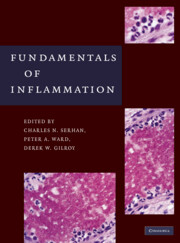Book contents
- Frontmatter
- Contents
- Contributors
- Preface
- PART I THE INFLAMMATORY RESPONSE – AN OVERVIEW
- PART II INDIVIDUAL CELL TYPES
- PART III CHEMICAL MEDIATORS
- 12 Lipid Mediators in Acute Inflammation and Resolution: Eicosanoids, PAF, Resolvins, and Protectins
- 13 Cytokines and Chemokines in Inflammation
- 14 Adenosine Receptors: Therapeutic Aspects for Inflammatory and Immune Diseases
- 15 Leukocyte Generation of Reactive Oxygen Species
- 16 Cell Adhesion Molecules
- PART IV IMMUNOPHARMACOLOGY
- PART V INFLAMMATORY DISEASES/HISTOLOGY
- PART VI ANIMAL MODELS OF INFLAMMATION
- Index
- References
13 - Cytokines and Chemokines in Inflammation
from PART III - CHEMICAL MEDIATORS
Published online by Cambridge University Press: 05 April 2014
- Frontmatter
- Contents
- Contributors
- Preface
- PART I THE INFLAMMATORY RESPONSE – AN OVERVIEW
- PART II INDIVIDUAL CELL TYPES
- PART III CHEMICAL MEDIATORS
- 12 Lipid Mediators in Acute Inflammation and Resolution: Eicosanoids, PAF, Resolvins, and Protectins
- 13 Cytokines and Chemokines in Inflammation
- 14 Adenosine Receptors: Therapeutic Aspects for Inflammatory and Immune Diseases
- 15 Leukocyte Generation of Reactive Oxygen Species
- 16 Cell Adhesion Molecules
- PART IV IMMUNOPHARMACOLOGY
- PART V INFLAMMATORY DISEASES/HISTOLOGY
- PART VI ANIMAL MODELS OF INFLAMMATION
- Index
- References
Summary
SUMMARY
Mediators produced during inflammatory/immune responses dictate the type of response, as well as its magnitude (“quality and quantity”). The profile of cytokines and chemokines produced are responsible for the cell-to-cell communication that facilitates initial recognition of infection or damage. These signals, in turn, communicate with primary lymphoid tissues (the thymus and bone marrow) to mobilize inflammatory cells to the bloodstream. At the tissue site, chemokines and cytokines orchestrate leukocyte adhesion to vascular endothelium, extravasation, and localization of leukocytes at the site of inflammation. Recruitment of leukocyte populations into inflamed tissues is initiated by cytokine-induced expression of adhesion molecules on vascular endothelium. These adhesion molecules play an essential role in capturing and tethering circulating leukocytes from the bloodstream. Chemokines promote the tight adherence of leukocytes to activated endothelium, as well as direct the extravasation of cells into inflamed tissue. Cytokines and chemokines further coordinate the response of inflammatory effector cells as they arrive in inflamed tissues. The sequential activation and cellular recruitment cascades mediated by cytokines and chemokines are essential for successful resolution of infection or other tissue damage. However, overproduction or dysregulation of these inflammatory mediators can also lead to destructive, pathological consequences. This chapter will examine the role played by cytokines and chemokines in the initiation, amplification, and shaping of inflammatory responses.
- Type
- Chapter
- Information
- Fundamentals of Inflammation , pp. 175 - 185Publisher: Cambridge University PressPrint publication year: 2010
References
- 2
- Cited by



